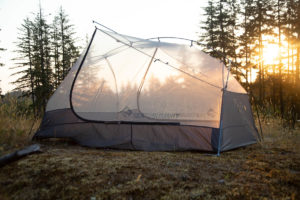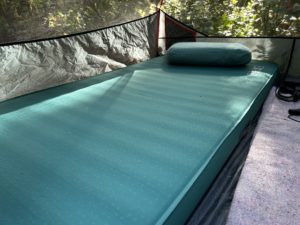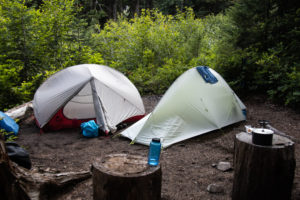Small, light backpacking tents are what most people use for shelter when they’re out backpacking. There are other options like hammocks and tarps but they require a little bit more experience and we don’t recommend you start there.
A backpacking tent is small, light and easy to set up. They can hold 1 to 4 people and usually are a mesh body covered with a waterproof fly.
On this page
How to Buy a Backpacking Tent
Size
The size of your backpacking tent will be your biggest decision. Is it a 1-person, just for yourself? Is it a 2-person for yourself and maybe 1 other? Or is it bigger for the whole family, maybe a 3- or 4-person?
Most people opt for a 2-person. The size is great for 2 people or nice and spacious for 1. Many tent pads and camping spots fit a 2- or 1-person tent well. The pieces divide up in half easy. The tent body can go into one persons tent and the tent poles and fly can go into another.
Weight
Size and weight are closely linked with backpacking tents. A 2 person tent is going to weigh more than a 1 person. A 3 person tent is going to weigh more than a 2 person.
There are certainly exceptions to this as the price gets higher and the fabrics get thinner and thinner. A more expensive 2- or 3-person tent with very thin, lightweight fabric can weigh less than a 1-person tent made from thicker, heavier materials.
Buy as light a tent as you can afford. It’s a large piece of gear in your pack and can weigh 4 or 5 pounds or more.
Durability
Even cheap tents are quite durable. The thicker the fabric the more durable it is. That said, you still have to be quite careful with tents. The mesh and fly are thin can tear easily. A waterproof fly with a hole in it isn’t waterproof any more.
Putting down a tarp or ground sheet (often called a footprint) protects the bottom of your tent from sharp sticks and rocks. It’s easier to replace a small tarp or piece of plastic under your tent than a whole tent body. As with everything else, it is something more to carry carry in your pack.
Non-Tent Shelter Options
Tents are usually the easiest to start with for backpacking but there are other options. Hammocks and tarps are 2 other ways to stay dry and warm when backpacking.
Hammocks
Backpacking hammocks aren’t your normal backyard hammock on a stand but the idea is the same. A very thin, light piece of fabric is hung between 2 trees. A bug net and tarp usually sit on top to keep you out of the bugs and rain. The ground doesn’t have to be smooth or flat under the hammock but there needs to be trees or rocks to attach either end of the hammock to.
Some people love sleeping in hammocks and some people hate it. It’s a good thing to test out at home before going on a week-long backpacking trip. With no poles to hold up the hammock, they often pack down smaller and lighter than backpacking tents do. Keep in mind they’ll always be 1-person.
Tarps
If you’re comfortable, pitching a tarp above you to protect you from the elements is all you need to sleep outside. There are many different shapes of tarps from regular rectangles to tent-shaped shells. Tarps usually require some way to pitch them and hold them up, with either trekking poles holding up either end or a rope from one tree to another. Tying edges and corners to trees or tent pegs will hold everything taught.
Nothing
The minimalist approach to camping is just throwing your sleeping bag on the ground and sleeping under the stars. This doesn’t offer any protection from bugs or rain but it can feel very freeing.
Tent Glossary
Bathtub floor – The waterproof floor that comes up about 6 inches from the ground. Keeps water out if you end up in a puddle in the middle of the night.
Fly – A tent fly is the waterproof fabric that goes overtop of the mesh body. Not all tents are 2 layers like this but most for backpacking are.
Footprint – A small nylon tarp that fits to the bottom of your tent and protects it from sharp sticks and rocks.
No-see-um Mesh – The very fine mesh built into the bodies of tents. Keeps out bugs like no-see-ums and mosquitos.
Gear Attic – An optional small hanging shelf in the top of some tents.
Tent Reviews
- Sea to Summit Telos TR2 Tent Review
 The Sea to Summit Telos TR2 Tent from Sea to Summit is a lightweight backpacking tent with a few features never before seen on a tent.
The Sea to Summit Telos TR2 Tent from Sea to Summit is a lightweight backpacking tent with a few features never before seen on a tent.
Other Backpacking Gear
You’ll need more than just a tent to head out backpacking. Here are buying guides to all the other gear you need for backpacking.
- EXPED MegaMat LXW Sleeping Pad ReviewCamping is so much better when you get a good night sleep. With backpacking, hiking all day almost guarantees a good night sleep. But with… Read More »EXPED MegaMat LXW Sleeping Pad Review
- Backpacking Gear for Beginners CourseWelcome to the Backpacking Gear for Beginners Course. This course will walk you through every piece of hiking gear you might need for a short… Read More »Backpacking Gear for Beginners Course
- Backpacking Gear for Beginners: DishesThis post is part of the Backpacking Gear for Beginners course. Why do you need dishes? You probably want to eat while you’re backpacking, right? That usually… Read More »Backpacking Gear for Beginners: Dishes
- Backpacking Gear for Beginners: CompassThis post is part of the Backpacking Gear for Beginners course. Why do you need a compass? Some maps show trails, lake names and mountain… Read More »Backpacking Gear for Beginners: Compass
- Backpacking Gear for Beginners: Coffee MakerThis post is part of the Backpacking Gear for Beginners course. Why do you need a coffee maker? I don’t go far without my Aeropress coffee maker… Read More »Backpacking Gear for Beginners: Coffee Maker
- Backpacking Gear for Beginners: CameraWhy do you need a camera? Another optional piece of gear. I don’t go on many trips without a camera though. It’s an excellent tool… Read More »Backpacking Gear for Beginners: Camera
- Backpacking Gear for Beginners: Trekking PolesThis post is part of the Backpacking Gear for Beginners course. Why do you need trekking poles? Trekking poles are walking sticks with soft handles,… Read More »Backpacking Gear for Beginners: Trekking Poles
- Backpacking Gear for Beginners: Water filter, drops and tabletsThis post is part of the Backpacking Gear for Beginners course. Why do you need a water filter? No matter where you are, there’s a chance the… Read More »Backpacking Gear for Beginners: Water filter, drops and tablets
- Backpacking Gear for Beginners: RopeThis post is part of the Backpacking Gear for Beginners course. Why do you need rope? Rope can be a very useful thing to have on the… Read More »Backpacking Gear for Beginners: Rope
- Backpacking Gear for Beginners: HeadlampThis post is part of the Backpacking Gear for Beginners course. Why do you need a headlamp? Around camp and possibly on the trail, you’ll… Read More »Backpacking Gear for Beginners: Headlamp
- Backpacking Gear for Beginners: FoodThis post is part of the Backpacking Gear for Beginners course. Why do you need food? Well, we need food to survive so I guess we’re taking… Read More »Backpacking Gear for Beginners: Food
- Backpacking Gear for Beginners: MusicThis post is part of the Backpacking Gear for Beginners course. Why do you need a music player? You don’t. If you like music and it’s going… Read More »Backpacking Gear for Beginners: Music
- Backpacking Gear for Beginners: WatchThis post is part of the Backpacking Gear for Beginners course. Why do you need a watch? Having a watch on the trail, even a… Read More »Backpacking Gear for Beginners: Watch
- Backpacking Gear for Beginners: Hiking ClothesThis post is part of the Backpacking Gear for Beginners course. Clothes for hiking are an important part of staying warm, dry, comfortable, and safe. Pick your… Read More »Backpacking Gear for Beginners: Hiking Clothes
- Backpacking Gear for Beginners: Satellite Communicators and Emergency Locator BeaconsThis post is part of the Backpacking Gear for Beginners course. Why do you need a satellite communicator? First off, what is a satellite communicator or messenger?… Read More »Backpacking Gear for Beginners: Satellite Communicators and Emergency Locator Beacons
- Backpacking Gear for Beginners: Pack CoverThis post is part of the Backpacking Gear for Beginners course. Why do you need a pack cover? A pack cover is a waterproof cover… Read More »Backpacking Gear for Beginners: Pack Cover
- Backpacking Gear for Beginners: BaselayersThis post is part of the Backpacking Gear for Beginners course. Why do you need base layers? The base layer, or underwear layer, is the first layer… Read More »Backpacking Gear for Beginners: Baselayers
- Backpacking Gear for Beginners: Bear SafetyThis post is part of the Backpacking Gear for Beginners course. Why do you need bear safety gear? There are a couple items related to bears that… Read More »Backpacking Gear for Beginners: Bear Safety
- Backpacking Gear for Beginners: PotsThis post is part of the Backpacking Gear for Beginners course. Why do you need pots to cook? Just like at home, you’ll need dishes and cookware… Read More »Backpacking Gear for Beginners: Pots
- Backpacking Gear for Beginners: MidlayersThis post is part of the Backpacking Gear for Beginners course. Why do you need middle layers? On top of your base layers you’ll have midlayers, often… Read More »Backpacking Gear for Beginners: Midlayers

